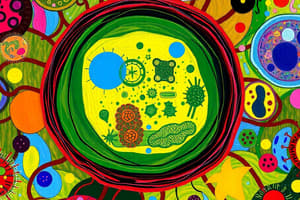Podcast
Questions and Answers
Which statement accurately describes the cell theory?
Which statement accurately describes the cell theory?
- Cells are the minimum unit of life.
- All cells arise from spontaneously generated material.
- All living organisms are made up of one or more cells. (correct)
- All forms of life are composed of multiple cells only.
What is the primary function of ribosomes in a cell?
What is the primary function of ribosomes in a cell?
- Breaking down waste materials.
- Modifying and sorting proteins.
- Synthesis of proteins. (correct)
- Generating adenosine triphosphate (ATP).
How do lysosomes contribute to cellular health?
How do lysosomes contribute to cellular health?
- They produce energy through cellular respiration.
- They contain enzymes that digest waste materials. (correct)
- They absorb nutrients from the environment.
- They synthesize proteins for cellular functions.
What role does the Golgi apparatus play in a cell?
What role does the Golgi apparatus play in a cell?
In which cellular process are mitochondria primarily involved?
In which cellular process are mitochondria primarily involved?
What would likely happen if lysosomes were non-functional due to a mutation?
What would likely happen if lysosomes were non-functional due to a mutation?
What does the presence of numerous mitochondria in a cell generally indicate?
What does the presence of numerous mitochondria in a cell generally indicate?
Why is the cell considered the basic unit of structure and organization in organisms?
Why is the cell considered the basic unit of structure and organization in organisms?
What typically occurs in metaphase during mitosis?
What typically occurs in metaphase during mitosis?
Which statement accurately describes a difference between mitosis and meiosis?
Which statement accurately describes a difference between mitosis and meiosis?
An error during anaphase II of meiosis may lead to which condition?
An error during anaphase II of meiosis may lead to which condition?
What happens if a gamete with an extra chromosome fuses with a normal gamete?
What happens if a gamete with an extra chromosome fuses with a normal gamete?
Which genetic disorder is caused by a genetic mutation and not an issue with chromosome number?
Which genetic disorder is caused by a genetic mutation and not an issue with chromosome number?
Which of the following statements about hemophilia and sickle cell anemia is true?
Which of the following statements about hemophilia and sickle cell anemia is true?
What is the primary role of meiosis in sexually reproducing organisms?
What is the primary role of meiosis in sexually reproducing organisms?
What characterizes the G0 phase of the cell cycle?
What characterizes the G0 phase of the cell cycle?
What is the primary function of root hairs in plants?
What is the primary function of root hairs in plants?
Which phase of the cell cycle includes DNA replication?
Which phase of the cell cycle includes DNA replication?
During which stage of mitosis does the nuclear envelope begin to disintegrate?
During which stage of mitosis does the nuclear envelope begin to disintegrate?
What does the G1 phase of interphase primarily focus on?
What does the G1 phase of interphase primarily focus on?
Which of the following describes a consequence of premature entry into the S phase?
Which of the following describes a consequence of premature entry into the S phase?
What role do flagella play in bacterial cells?
What role do flagella play in bacterial cells?
What is the primary purpose of the G2 phase in the cell cycle?
What is the primary purpose of the G2 phase in the cell cycle?
How many stages are there in mitosis?
How many stages are there in mitosis?
What is the primary function of the Rough Endoplasmic Reticulum (RER)?
What is the primary function of the Rough Endoplasmic Reticulum (RER)?
What is the main component of the cell walls in most prokaryotic cells?
What is the main component of the cell walls in most prokaryotic cells?
Which of the following is not a function of the Smooth Endoplasmic Reticulum (SER)?
Which of the following is not a function of the Smooth Endoplasmic Reticulum (SER)?
What do prokaryotic cells primarily use for reproduction?
What do prokaryotic cells primarily use for reproduction?
Which substance is primarily stored in the Smooth Endoplasmic Reticulum (SER)?
Which substance is primarily stored in the Smooth Endoplasmic Reticulum (SER)?
What provides structural support and helps to maintain cell shape in prokaryotic cells?
What provides structural support and helps to maintain cell shape in prokaryotic cells?
Which of the following statements is true regarding eukaryotic plant cell walls?
Which of the following statements is true regarding eukaryotic plant cell walls?
What role does the RER play in relation to lysosomes?
What role does the RER play in relation to lysosomes?
What occurs to a cell when it is in a hypertonic environment due to high NaCl concentration?
What occurs to a cell when it is in a hypertonic environment due to high NaCl concentration?
Which of the following best describes phagocytosis?
Which of the following best describes phagocytosis?
How does endocytosis differ from exocytosis?
How does endocytosis differ from exocytosis?
What is the primary distinction between phagocytosis and pinocytosis?
What is the primary distinction between phagocytosis and pinocytosis?
What is the consequence of dehydration in a cell due to osmotic stress?
What is the consequence of dehydration in a cell due to osmotic stress?
Which process is significantly more efficient for nutrient uptake?
Which process is significantly more efficient for nutrient uptake?
In the process of plasmolysis, which one of the following is observed?
In the process of plasmolysis, which one of the following is observed?
What is the outcome of water loss in animal cells under high salt conditions?
What is the outcome of water loss in animal cells under high salt conditions?
Flashcards
Cell Theory
Cell Theory
All living organisms are composed of one or more cells, which are the fundamental units of life.
Cell, fundamental unit of what?
Cell, fundamental unit of what?
Life
New cells?
New cells?
Arise from pre-existing cells.
Ribosomes function
Ribosomes function
Signup and view all the flashcards
Golgi Apparatus role
Golgi Apparatus role
Signup and view all the flashcards
Mitochondria function
Mitochondria function
Signup and view all the flashcards
Lysosomes job
Lysosomes job
Signup and view all the flashcards
Rough ER function
Rough ER function
Signup and view all the flashcards
Smooth ER function
Smooth ER function
Signup and view all the flashcards
Prokaryotic cell walls
Prokaryotic cell walls
Signup and view all the flashcards
Plant cell wall composition
Plant cell wall composition
Signup and view all the flashcards
Prokaryotic cell wall function
Prokaryotic cell wall function
Signup and view all the flashcards
Plant cell wall function
Plant cell wall function
Signup and view all the flashcards
Binary Fission
Binary Fission
Signup and view all the flashcards
Root Hairs
Root Hairs
Signup and view all the flashcards
Flagella function
Flagella function
Signup and view all the flashcards
Cell Cycle Phases
Cell Cycle Phases
Signup and view all the flashcards
Mitosis and its importance
Mitosis and its importance
Signup and view all the flashcards
Meiosis
Meiosis
Signup and view all the flashcards
Anaphase II error
Anaphase II error
Signup and view all the flashcards
Genetic disorder example
Genetic disorder example
Signup and view all the flashcards
Osmotic Stress & effect on cells
Osmotic Stress & effect on cells
Signup and view all the flashcards
Phagocytosis
Phagocytosis
Signup and view all the flashcards
Pinocytosis
Pinocytosis
Signup and view all the flashcards
Nutrient Uptake Efficiency
Nutrient Uptake Efficiency
Signup and view all the flashcards
Study Notes
Cell Theory
- All living organisms consist of one or more cells, making cells the fundamental unit of life.
- Cells serve as the smallest living units that perform life processes and form the structural and functional organization of organisms.
- New cells arise from the division of pre-existing cells, highlighting cell division as vital for growth and reproduction.
Cellular Organelles
- Ribosomes: Sites of protein synthesis, translating mRNA into protein by linking amino acids.
- Golgi Apparatus: Modifies, sorts, and packages proteins and lipids from the endoplasmic reticulum (ER) for various cellular destinations.
- Mitochondria: Known as the "powerhouses" of the cell, generate ATP through cellular respiration and regulate metabolism and apoptosis.
- Lysosomes: Contain digestive enzymes for breaking down waste and cellular debris; important for recycling cell components.
- Rough Endoplasmic Reticulum (RER): Studded with ribosomes for protein synthesis and modification, crucial for proteins secreted or sent to organelles.
- Smooth Endoplasmic Reticulum (SER): Lacks ribosomes; synthesizes lipids, detoxifies drugs, metabolizes carbohydrates, and stores calcium ions.
Cell Wall Composition
- Prokaryotic Cells: Most cell walls are made of peptidoglycan; archaea may consist of pseudopeptidoglycan or unique polysaccharides.
- Eukaryotic Plant Cells: Primarily composed of cellulose, with additional components like hemicelluloses and pectin for rigidity and strength.
Cell Functions
- Prokaryotic Cell Wall: Provides structural support, maintains shape, and protects against environmental stresses.
- Eukaryotic Plant Cell Wall: Responsible for structural support, protection, shape maintenance, and regulates cell growth.
Reproductive Methods
- Prokaryotic cells reproduce through binary fission, where one cell divides into two identical daughter cells.
Root Hairs and Flagella
- Root Hairs: Extensions that increase surface area for water and nutrient absorption in plants.
- Flagella: Whip-like structures aiding movement; propel animal cells and assist bacteria in locomotion.
Cell Cycle
- Phases: Comprises Interphase (G1, S, G2) and Mitotic Phase (M Phase).
- Interphase: Cell grows and prepares for division; longest phase, includes G1, S, and G2 stages.
- Mitotic Phase: Divides into two daughter cells; includes mitosis and cytokinesis.
Mitosis vs. Meiosis
- Mitosis aligns sister chromatids in a single row during metaphase, while meiosis aligns homologous chromosomes in pairs.
- Mitosis promotes growth; meiosis ensures genetic diversity through unique gene combinations.
Errors in Meiosis
- Errors during anaphase II can lead to gametes with abnormal chromosome numbers, potentially causing genetic disorders such as Down syndrome or Turner syndrome.
Genetic Disorders
- Huntington's Disease: A genetic mutation causing neurodegenerative problems.
- Hemophilia: Affects blood clotting mechanisms.
- Sickle Cell Anemia: Impairs red blood cell morphology and function.
Osmotic Stress
- High NaCl concentrations can cause water loss from cells, leading to crenation in animal cells and plasmolysis in plant cells, affecting cell function and structure.
Endocytosis and Exocytosis
- Phagocytosis: Cell "eats" large particles or microorganisms; common in immune cells.
- Pinocytosis: Cell "drinks" extracellular fluid and small molecules; important for nutrient absorption.
- Exocytosis: Vesicles fuse with the membrane to release substances outside the cell.
- Endocytosis: Membrane invaginates to internalize substances, reducing membrane surface area.
Nutrient Uptake Efficiency
- Endocytosis is generally more efficient for nutrient uptake as it allows cells to selectively absorb necessary substances.
Studying That Suits You
Use AI to generate personalized quizzes and flashcards to suit your learning preferences.




